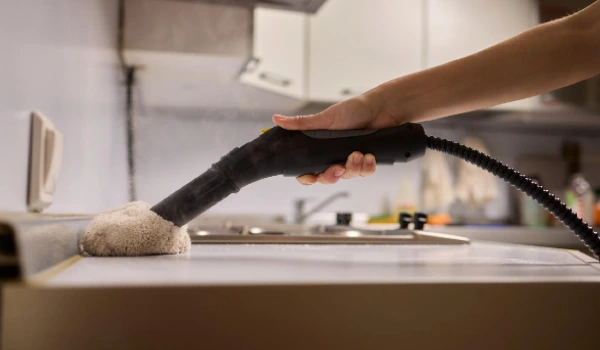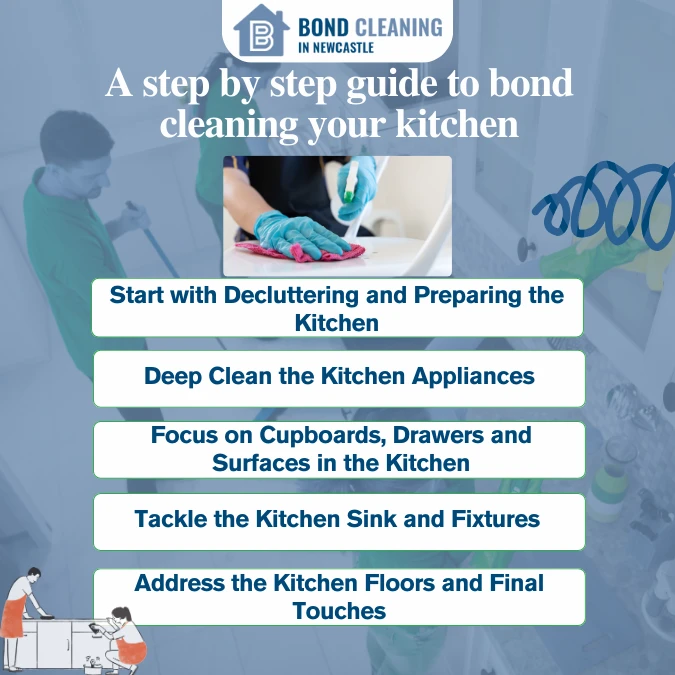Kitchen Bond Cleaning: A Step By Step Guide To Get Your Bond Back
Moving out of a rental property, comes with a long to do list, but nothing is as crucial as ensuring the kitchen is spotless. Property managers and landlords pay extra attention to this space because it’s the heart of the home and also the one that collects the most grime, grease, and stains over time. A well cleaned kitchen can often be the deciding factor in whether you get your bond back.
For tenants, top quality end of lease cleaning Newcastle services are always an option, but many prefer to roll up their sleeves and tackle the cleaning themselves. This article, will provide a step by step guide for bond cleaning your kitchen. With the correct approach and a systematic plan you can restore your kitchen to its original condition and make a lasting impression during the final inspection.
Hide
Show
]- Start with Decluttering and Preparing the Kitchen
- Deep Clean the Kitchen Appliances
- Focus on Cupboards, Drawers and Surfaces in the Kitchen
- Tackle the Kitchen Sink and Fixtures
- Address the Kitchen Floors and Final Touches
- When to Consider Professional Kitchen Cleaning
- Infographic: A step by step guide to bond cleaning your kitchen
- Wrapping Up
1. Start with Decluttering and Preparing the Kitchen
Before diving into the scrubbing, begin by removing everything from your kitchen cupboards, pantry, and refrigerator. Food items, cutlery, small appliances, and even decor need to be packed away. This clears out all surfaces and ensures you won’t miss hidden spots where dust and crumbs usually gather.
Once the space is empty, gather your cleaning tools, sponges, scrubbing brushes, microfibre cloths, gloves, baking soda, vinegar, and a good degreaser. Having everything at arm’s length will save time and help you stay on track. Preparation is key, to avoiding unnecessary delays.
2. Deep Clean the Kitchen Appliances
Kitchen appliances are high on the landlord’s checklist during an inspection. Each one needs individual attention to ensure there are no signs of grease, food residue, or odours.
- Oven; remove the racks and soak them in hot soapy water. Scrub the inside walls with a baking soda paste or degreaser. Don’t forget the oven door and knobs.
- Stovetop and rangehood; degrease thoroughly paying attention to burners, drip pans and filters in the rangehood. These are common spots where grease builds up.
- Microwave and dishwasher; wipe down interiors, remove stains, and run a cleaning cycle if possible.
- Fridge and freezer: defrost, wipe shelves and deodorise with baking soda.
Leaving appliances sparkling clean instantly improves the overall presentation of the kitchen.
3. Focus on Cupboards, Drawers and Surfaces in the Kitchen

Cupboards and drawers usually accumulate crumbs, oil splatters, and dust over time. Begin by vacuuming or cleaning the inside, then scrape them with a gentle cleanser. Pay special attention to the handles and edges, which tend to display fingerprints and stains.
For benchtops and splashbacks; use appropriate cleaning products depending on the material, stone, laminate, or tiles. Avoid using harsh chemicals that can damage surfaces. Don’t ignore grout lines in tiled areas, as discolouration can make the kitchen look messy. A toothbrush dipped in vinegar or baking soda works well here.
4. Tackle the Kitchen Sink and Fixtures
The sink is one of the most often used areas in the kitchen so it naturally shows indications of wear, limescale and water stains. Scrub it with baking soda and dish soap, then thoroughly rinse. Buff stainless steel sinks with a dry towel to get a polished sheen.
Don’t ignore the taps and fittings. Hard water stains and fingerprints can dull its appearance. To restore shine, use vinegar or limescale remover. Also, check the drain for any food particles or clogs to avoid unpleasant odours. A gleaming sink area is a minor detail that makes a significant difference during end of lease cleaning Newcastle inspections.
5. Address the Kitchen Floors and Final Touches
The last step in your kitchen bond cleaning process is to clean the flooring and give the space a final inspection. Sweep and vacuum thoroughly to eliminate dust and crumbs then mop with a safe floor cleaner. Pay attention to corners and edges where dirt tends to gather.
Finally, wipe off the light switches, skirting boards, and door handles. These are little details that are usually neglected but become evident during the inspection. Once completed, stroll around your kitchen with a landlord’s viewpoint to ensure that everything is clean and ready.
6. When to Consider Professional Kitchen Cleaning
While DIY cleaning is doable with time and effort, certain kitchens require specialised attention especially if there is heavy grease or stubborn stains. Hiring professionals for end of lease cleaning Newcastle assures that the job is done to industry standards. Many cleaning businesses provide bond back guarantees which give you peace of mind and reduce the stress of moving out. If your schedule is tight or the kitchen has seen a lot of use, hiring an expert may save you time and the danger of bond deductions.
Infographic: A step by step guide to bond cleaning your kitchen

Wrapping Up
Kitchen bond cleaning, can seem overwhelming; but with a planned strategy it becomes manageable. Declutter first then move on to appliances, cupboards, sinks and floors. Paying attention to detail; will help you impress your landlord or property manager. And remember, whether you do it yourself or hire professionals for end of lease cleaning, the work you put into the kitchen has a direct impact on your chances of receiving your bond back.

